As a companion to previous post, here’s more drawings of the same iconic project.
From the description of the project:
OMA received an honorable mention for Très Grande Bibliothèque, a competition to build a new national library in France. The program called for the creation of various smaller libraries contained in one building envelope; including libraries for moving images, recent acquisitions, reference, catalogues and scientific research. The immense amount of information to be stored within these spaces (books, films, digital databases) became the impetus for the overall concept design. The library is imagined as a solid block of information, a dense repository for the past, from which voids are carved to create public spaces – absence floating in memory.
The ambition of this project is to rid architecture of responsibilities it can no longer sustain and to explore this new freedom aggressively. It suggests that, liberated from its former obligations, architecture’s last function will be the creation of the symbolic spaces that accommodate the persistent desire for collectivity.
At the moment when the electronics revolution seems about to melt all that is solid – to eliminate all necessity for concentration and physical embodiment – it seems absurd to imagine the ultimate library.
But that was exactly what the French government proposed when it organized a competition for the TGB in the summer of 1998: 250,000m2 on the east side of Paris on a site near the Periphérique, facing the Seine.
Along with conference centers, restaurants, offices, etc., it would consolidate five separate and autonomous institutions in which the complete production of words and images since 1945 – the Bibliothèque is as much cinema as library – would be contained: a cinemateque, a library of catalogues, and a scientific research library.
The scheme is based on technological scenarios developed with inventors, systems analysts, writers and electronics companies. They all anticipate the utopia of fully integrated information systems to materialize before the opening of the building: books, films, music, computers will be read on the same magic tablets. The future will not spell the end of the book but a period of new equalities.
The Very Big Library is interpreted as a solid block of information, a repository of all forms of memory – books, laser disks, microfiche, computers and databases. In this block, the major public spaces are defined as absences of building, voids carved out of the information solid. Floating in memory, they are multiple embryos, each with its own technological placenta.
Partner in charge:
Rem Koolhaas
Competition Team:
Art Zaaijer, Xaveer de Geyter, Georges Heintz, Heike Lohmann, Ron Steiner, Alex Wall, Christophe Cornubert, Ramon Klein, Yushi Uehara
Engineers:
Cecil Balmond, Mohsen Zikri of Arup




































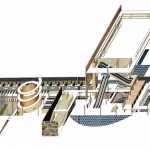
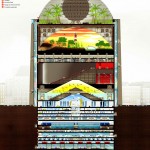
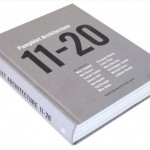
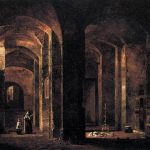
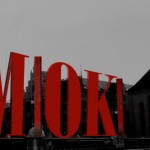
[…] NETHERLANDS STRATEGY OF THE VOID: BUILDING THE MODEL OF OMA’S TRÈS GRANDE BIBLIOTHÈQUE OMA’S TRÈS GRANDE BIBLIOTHÈQUE – (MORE) ‘WE’RE BUILDING ASSEMBLY-LINE CITIES AND BUILDINGS’ – A KOOLHAAS INTERVIEW POLÉMIQUE, ÇA […]